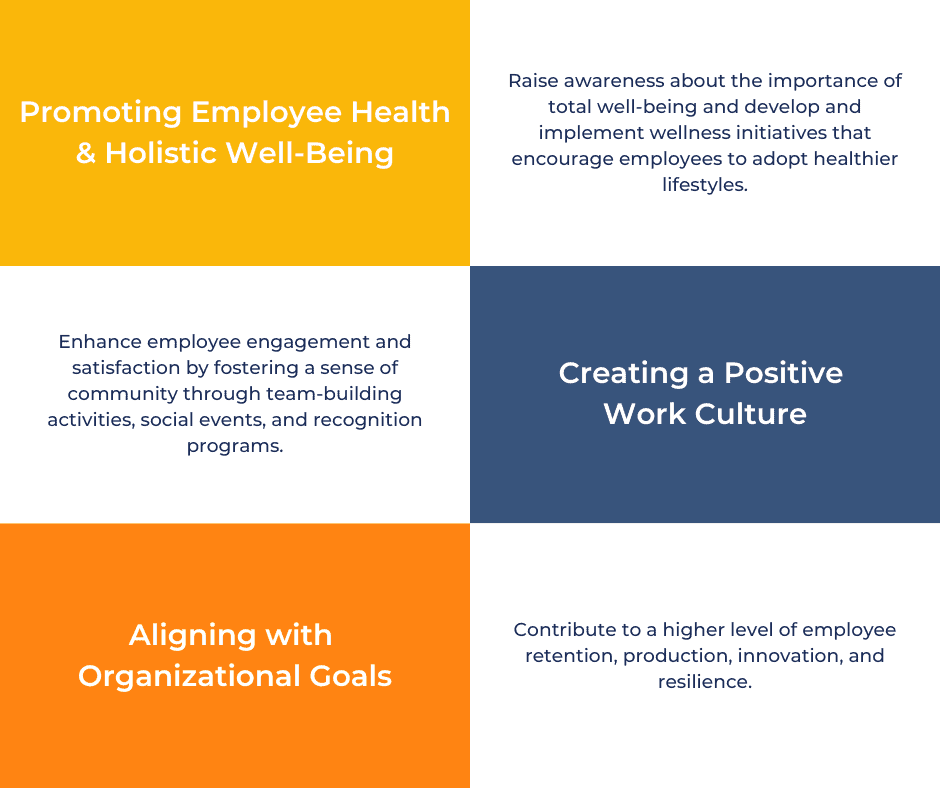Establishing a Workplace Wellness Committee
Organizations striving to create a thriving and high-performing workforce can establish a wellness committee to be a catalyst for positive change. This dedicated group of individuals champions the cause of corporate wellness, creating an environment that nurtures the physical, mental, social, and emotional well-being of employees. In this article, we delve into the many benefits of implementing a workplace wellness committee.
How to Form a Workplace Wellness Committee
In this post:
1. What is the Purpose of a Wellness Committee?
2. How to Start a Wellness Committee at Work
3. Committee Structure & Functions
6. Measuring & Improving the Corporate Wellness Committee
What is the Purpose of a Wellness Committee?
A workplace wellness committee is an instrumental driver in an organization’s commitment to employee well-being. It embodies a comprehensive approach to cultivating a culture of wellness and integrating it into the fabric of the company. The primary objectives of a wellness committee include:
- Promoting employee health & holistic well-being — raise awareness about the importance of total well-being and develop and implement wellness initiatives that encourage employees to adopt healthier lifestyles.
- Creating a positive work culture — enhance employee engagement and satisfaction by fostering a sense of community through team-building activities, social events, and recognition programs.
- Aligning with organizational goals — contribute to a higher level of employee retention, production, innovation, and resilience.
This cross-functional group of people with a passion for health and wellness steers the wellness program by assisting with administration and representing the employee population. A wellness committee informs decision-making and helps push business initiatives forward by championing the health and wellness of the organization.

How to Start a Wellness Committee at Work
Depending on the size of your population, wellness committees generally consist of five to twelve people representing various departments and roles within the organization. An assessment can be made to determine how the wellness committee should be using surveys, focus groups, and consultations with HR and key stakeholders pushing wellness initiatives forward. This also provides an opportunity to gain management support by communicating how a wellness committee boosts morale and productivity by aligning its objectives with company goals.
After identifying individuals enthusiastic about wellness, secure their commitment to allocating time to the wellness committee. Some organizations choose to build membership responsibilities into existing roles, but generally committee members dedicate their own time to the initiative. With wellness committee members chosen, evaluate the scope and member availability to determine the frequency of meetings. It’s important to hold consistent sessions to ensure progress and sustainability, and to formalize the committee with a mission statement that outlines its purpose, goals, and decision-making processes. Launch the wellness committee with a kick-off meeting where members are introduced, the mission is communicated, and employee input is encouraged.
Learn more about How-To Implement Corporate Wellness Programs.
Committee Structure & Functions
Assign specific roles to each member based on their expertise and interests, such as a chairperson, program coordinator, communications lead, or research analyst. Together, committee members plan and implement various wellness initiatives and develop a comprehensive wellness program strategy. This involves deploying an employee needs and interests survey, meeting with stakeholders and taking meeting minutes, creating communications, and evaluating the effectiveness of the program.
Organizations that choose to work with a wellness vendor like Strive free up the time of their committee members to focus on bigger picture initiatives by providing a needs and interests survey, preparing marketing communications, and assisting with the planning and measuring of the wellness program with data collection and analysis.
Collaboration & Engagement
Encouraging collaboration within the committee and engaging employees and management throughout the organization maximizes the wellness committee’s impact and ensures the well-being initiatives resonate with the population. Establish regular committee meetings to discuss progress, share ideas, and align efforts. Utilize the diverse skills and perspectives of committee members to develop multifaceted wellness programs.
Extend alliances beyond the committee and build an inclusive culture by asking cross-departmental representatives to contribute their insights, ideas, and expertise. Actively promote participation by leveraging various channels such as word-of-mouth, newsletters, fliers, email, and other intranet platforms to disseminate tailored communications. By encouraging employees to provide feedback, they develop a sense of ownership and feel empowered to contribute ideas for future initiatives. The more people invited into the culture of health, the more supportive and engaging the workplace environment becomes.
Resources & Budgeting
Proper planning is imperative for a thriving and sustainable wellness program. In addition to identifying personnel to serve on the wellness committee, the committee itself must collaborate with stakeholders to determine a dedicated budget. It’s important to explore funding options such as wellness grants, sponsorships, or partnerships with external organizations to supplement internal funding. Establishing a budget early on is vital as it drives the frequency of programming that will be available to your group.
Depending on the wellness initiatives your population is interested in, you’ll also want to consider the space available in your facility, any equipment you want to procure, and technology that can be utilized to streamline the administration of the wellness program. Strategic allocation of resources requires ongoing monitoring. Many corporate wellness programs start small and grow as the population becomes more engaged and the culture of health begins to flourish.
Measuring & Improving the Corporate Wellness Committee
A crucial component of any wellness initiative is to measure its success and continuously improve its impact. Using the wellness goals and company objectives established in the forming of the committee, identify budget limitations, resistance, or time constraints affecting the progress of the endeavor. Engaging employee feedback through surveys or suggestion boxes offers insights into employees’ perception of the wellness program, allowing the committee to pivot based on real needs and preferences.
The initial goals and objectives also inform which qualitative and quantitive data is relevant to the impact of the initiatives. Data is the backbone of any successful measurement process. In addition to employee feedback, data can be collected in the form of:
- Health assessments
- Participation rates
- Healthcare claims
- The physical & mental health behaviors of the workforce
- Employee satisfaction
- Attendance & productivity
- Retention rates
- Positivity of the work environment
It is the job of the wellness committee to analyze the data to identify trends, areas of improvement, and effectiveness of the wellness program over time. For example, low participation rates might indicate a lack of interest, inadequate communication, or a deficit of diversity in the offerings. Armed with data and insights, the wellness committee can adapt their strategy as the needs of the workforce evolve. A well-structured evaluation process is the key to long-term sustainability and engaging wellness programs.
Wellness Committees vs. Wellness Champion Strategy
While a wellness committee is formed across departments within a specific organization, a wellness champion strategy comes into play when several sectors exist within a larger entity, such as a city. For example, when Strive implemented the City of San Diego’s pilot wellness program, we created a wellness champions program. Because the budget was too conservative to impact the entire city population, a wellness champion from each sector (fire, police, public works, etc.) was appointed to attend quarterly meetings and return with helpful strategies to positively impact the culture of health in their own environment.
Strive Wellness Programs Build a Culture of Health
Strive supports wellness committees by preparing employee needs and interests surveys, proposing themes or offerings conducive to your unique workforce, providing marketing materials, and collecting and analyzing data to evolve your wellness program. Relieving administrative-heavy tasks allows those championing wellness to focus on pushing big picture initiatives forward, such as recognition programs or wellness challenges.
Rather than coordinating one-off events, Strive’s ethos for wellness is developing a culture of health within organizations through sustainable and engaging wellness programs. Our wraparound service delivery model makes wellness easy for organizations to introduce and for employees to participate in. Book a discovery call to explore how Strive can support your wellness goals.



